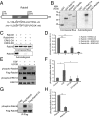Activation of Rab8 guanine nucleotide exchange factor Rabin8 by ERK1/2 in response to EGF signaling
- PMID: 25535387
- PMCID: PMC4291672
- DOI: 10.1073/pnas.1412089112
Activation of Rab8 guanine nucleotide exchange factor Rabin8 by ERK1/2 in response to EGF signaling
Abstract
Exocytosis is tightly regulated in many cellular processes, from neurite expansion to tumor proliferation. Rab8, a member of the Rab family of small GTPases, plays an important role in membrane trafficking from the trans-Golgi network and recycling endosomes to the plasma membrane. Rabin8 is a guanine nucleotide exchange factor (GEF) and major activator of Rab8. Investigating how Rabin8 is activated in cells is thus pivotal to the understanding of the regulation of exocytosis. Here we show that phosphorylation serves as an important mechanism for Rabin8 activation. We identified Rabin8 as a direct phospho-substrate of ERK1/2 in response to EGF signaling. At the molecular level, ERK phosphorylation relieves the autoinhibition of Rabin8, thus promoting its GEF activity. We further demonstrate that blocking ERK1/2-mediated phosphorylation of Rabin8 inhibits transferrin recycling to the plasma membrane. Together, our results suggest that ERK1/2 activate Rabin8 to regulate vesicular trafficking to the plasma membrane in response to extracellular signaling.
Keywords: ERK; Rab GTPases; Rab8; guanine nucleotide exchange factor; phosphorylation.
Conflict of interest statement
The authors declare no conflict of interest.
Figures






Similar articles
-
Biochemical analysis of Rabin8, the guanine nucleotide exchange factor for Rab8.Methods Cell Biol. 2015;130:59-68. doi: 10.1016/bs.mcb.2015.06.018. Epub 2015 Jul 29. Methods Cell Biol. 2015. PMID: 26360028
-
Kinetic activation of Rab8 guanine nucleotide exchange factor Rabin8 by Rab11.Methods Mol Biol. 2015;1298:99-106. doi: 10.1007/978-1-4939-2569-8_8. Methods Mol Biol. 2015. PMID: 25800835
-
Rabin8 regulates neurite outgrowth in both GEF activity-dependent and -independent manners.Mol Biol Cell. 2016 Jul 1;27(13):2107-18. doi: 10.1091/mbc.E16-02-0091. Epub 2016 May 11. Mol Biol Cell. 2016. PMID: 27170183 Free PMC article.
-
The guanine nucleotide exchange factor Tiam1: a Janus-faced molecule in cellular signaling.Cell Signal. 2014 Mar;26(3):483-91. doi: 10.1016/j.cellsig.2013.11.034. Epub 2013 Dec 2. Cell Signal. 2014. PMID: 24308970 Review.
-
Arf GTPase regulation through cascade mechanisms and positive feedback loops.FEBS Lett. 2013 Jun 27;587(13):2028-35. doi: 10.1016/j.febslet.2013.05.015. Epub 2013 May 16. FEBS Lett. 2013. PMID: 23684643 Review.
Cited by
-
Development of a Quantitative BRET Affinity Assay for Nucleic Acid-Protein Interactions.PLoS One. 2016 Aug 29;11(8):e0161930. doi: 10.1371/journal.pone.0161930. eCollection 2016. PLoS One. 2016. PMID: 27571227 Free PMC article.
-
Who's in control? Principles of Rab GTPase activation in endolysosomal membrane trafficking and beyond.J Cell Biol. 2021 Sep 6;220(9):e202105120. doi: 10.1083/jcb.202105120. Epub 2021 Aug 12. J Cell Biol. 2021. PMID: 34383013 Free PMC article. Review.
-
Detecting Endogenous Rab8 Activation.Methods Mol Biol. 2021;2293:45-56. doi: 10.1007/978-1-0716-1346-7_4. Methods Mol Biol. 2021. PMID: 34453709
-
Transcriptional and post-translational changes in the brain of mice deficient in cholesterol removal mediated by cytochrome P450 46A1 (CYP46A1).PLoS One. 2017 Oct 26;12(10):e0187168. doi: 10.1371/journal.pone.0187168. eCollection 2017. PLoS One. 2017. PMID: 29073233 Free PMC article.
-
Prohibitin-1 Contributes to Cell-to-Cell Transmission of Herpes Simplex Virus 1 via the MAPK/ERK Signaling Pathway.J Virol. 2021 Jan 13;95(3):e01413-20. doi: 10.1128/JVI.01413-20. Print 2021 Jan 13. J Virol. 2021. PMID: 33177205 Free PMC article.
References
Publication types
MeSH terms
Substances
Grants and funding
LinkOut - more resources
Full Text Sources
Other Literature Sources
Molecular Biology Databases
Miscellaneous

